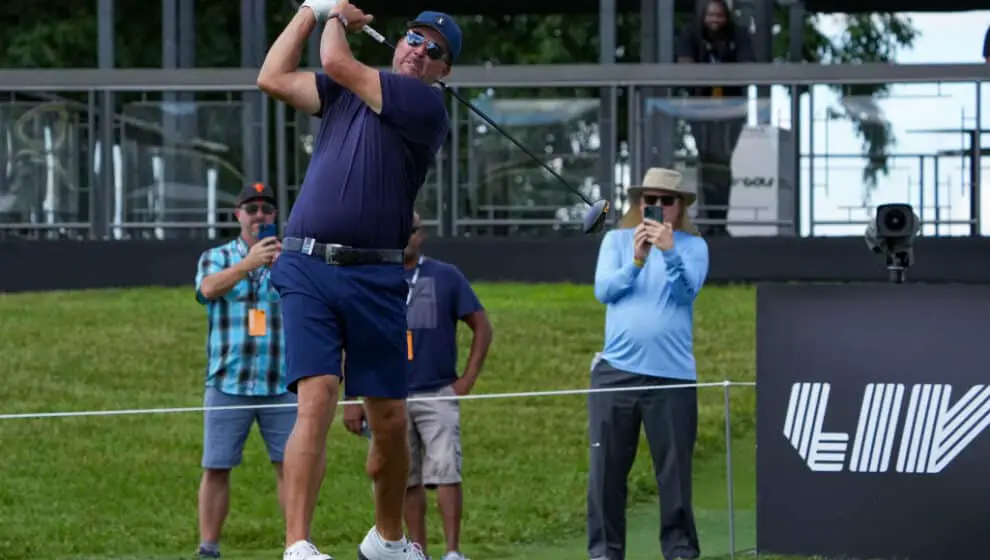LIV Golf has paid players some $800 million to leave the PGA Tour to join its team—and now many in the sport wonder if the Saudi-backed tour is making its money back from its player investments.
Key Details
- In June 2022, LIV Golf reported paid high-profile golfer Phil Mickelson $200 million to leave the PGA Tour and join the new league—he ranked number 34 of 48 LIV golfers in 2022, and so far this year, he is number 37.
- The new tour also purged multiple players from the PGA, including Brooks Koepka (ranked 38 in 2023), Bryson DeChambeau (ranked 34 in LIV for 2022), and Dustin Johnson (ranked 20 in LIV for 2023).
- LIV paid these and other players around $800 million total to leave the PGA, and so far, the players have not been performing, with the league questioning whether it is making a return on its investment.
Why it’s news
Since last summer, the Saudi Arabian-backed LIV Golf league has been shaking up the golf world as it began its debut by taking players from the PGA Tour with the promises of multimillion-dollar checks to grow its new league and compete with the PGA.
The big payouts attracted top golfers, with some of the biggest names in the sport leaving the prestigious PGA Tour to head to the newly founded league. However, to date, the investment has not paid off in terms of gaining an audience—as event attendance is low and broadcast ratings barely register a blip. Some are questioning whether the structure of LIV play is such that these top players are not incentivized to perform.
Golf legend Tiger Woods expressed his disappointment in July about the players leaving for LIV, which he says does not provide real competition for golfers. “What these players are doing for guaranteed money, what is the incentive to practice?’’ Woods says. “What is the incentive to go out there and earn it in the dirt? You’re just getting paid a lot of money upfront and playing a few events, and playing 54 holes. They’re playing blaring music and have all these atmospheres that are different.”
LIV paid most of these players more money upfront than they received over their entire PGA career, including Phil Mickelson, who earned around $94 million with the PGA and made $200 million to join LIV. The way LIV is set up, even the players ranked among the bottom are going home with at least some money, leading many players not to care what place they are ranked.
Every individual tournament winner receives $4 million, with the player who finished last in the 48-man events taking home $120,000, according to Today’s Golfer.
The players were paid multiple millions to leave the PGA and still receive a guaranteed six-figure payout when ranking in the bottom of a weekend tournament. In the PGA Tour, players who finish in the bottom half of the lineup for a weekend tournament receive nothing.
That is what LIV is facing right now, as the players it thought would be the leaders are not regularly breaking the top 10.
Cameron Smith was among the last to join LIV, with an estimated payout of $100 million. He started well, winning the opening championship of LIV and a second title in Chicago, but after that, he has only ranked in the top 20 players out of 48.
Brooks Koepka was also paid around $100 million to defect from the PGA Tour and has only ranked 31st and 29th in 2023, landing him around the 38th spot, according to LIV.
Bryson DeChambeau reportedly made $125 million to join LIV and hasn’t done anything to show out for LIV thus far. He ended 2022 ranked number 21 in the league, and so far this year, he is number 34.
Dustin Johnson also made around $125 million to join LIV and started off on top, winning the LIV individual season in 2022. He is currently ranked 20th for 2023.
Lastly, the highest-paid player to leave the PGA for LIV is Phil Mickelson, who was paid nearly $200 million to join the new league and has some of the worst stats. He ranked number 34 of 48 in 2022, and so far this year, he is number 37.
LIV has dished out a considerable amount of money to get its golf league off the ground, and the league even admitted last year that it had very little return after paying large amounts for players, matches, and other deals that didn’t work out.
The league has officially secured a good TV deal and hopes that 2023 will be the year it begins to get off the ground and bring in revenue, more players, and more fans.
